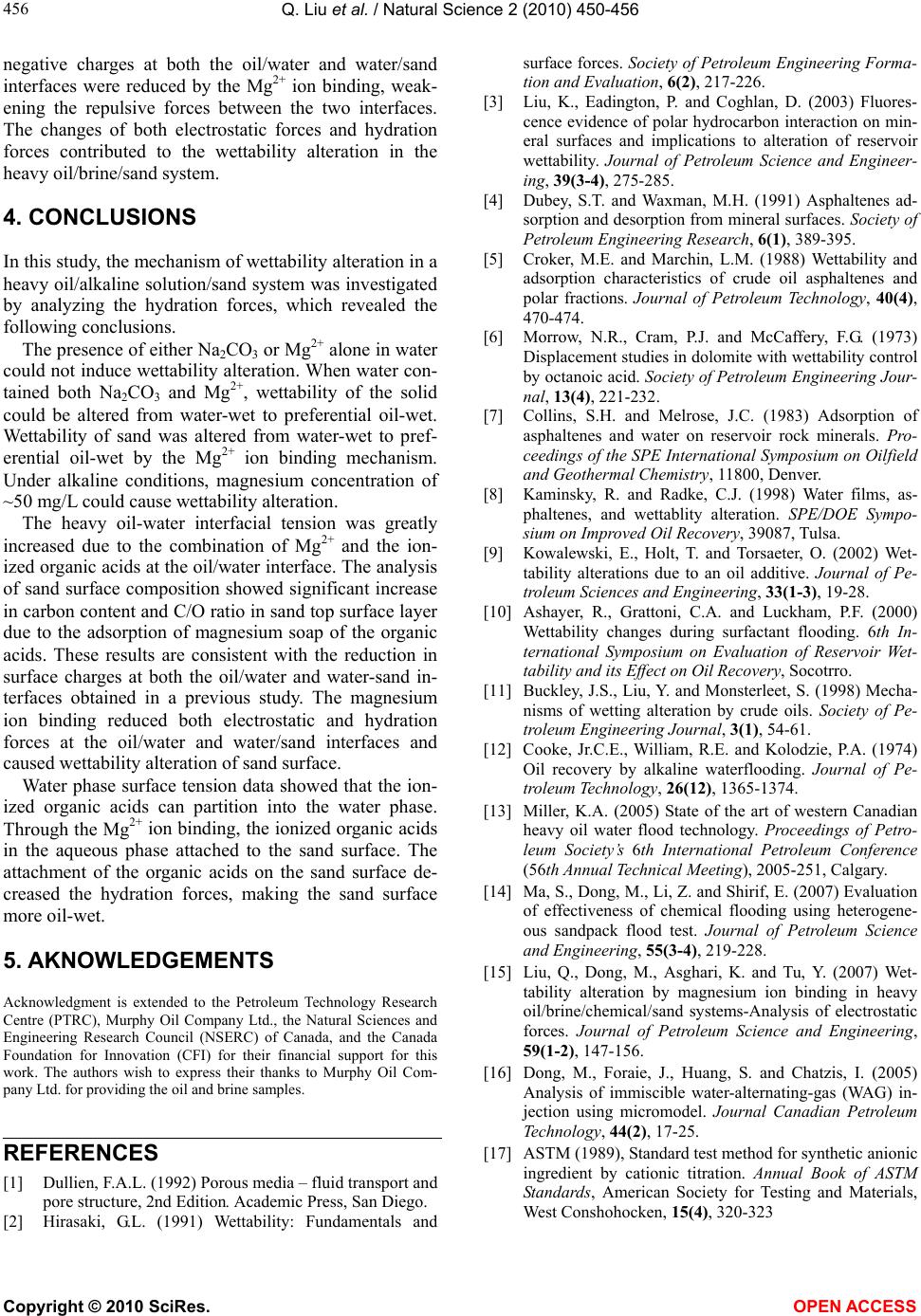
Q. Liu et al. / Natural Science 2 (2010) 450-456
Copyright © 2010 SciRes. OPEN ACCESS
456
negative charges at both the oil/water and water/sand
interfaces were reduced by the Mg2+ ion binding, weak-
ening the repulsive forces between the two interfaces.
The changes of both electrostatic forces and hydration
forces contributed to the wettability alteration in the
heavy oil/brine/sand system.
4. CONCLUSIONS
In this study, the mechanism of wettability alteration in a
heavy oil/alkaline solution/sand system was investigated
by analyzing the hydration forces, which revealed the
following conclusions.
The presence of either Na2CO3 or Mg2+ alone in water
could not induce wettability alteration. When water con-
tained both Na2CO3 and Mg2+, wettability of the solid
could be altered from water-wet to preferential oil-wet.
Wettability of sand was altered from water-wet to pref-
erential oil-wet by the Mg2+ ion binding mechanism.
Under alkaline conditions, magnesium concentration of
~50 mg/L could cause wettability alteration.
The heavy oil-water interfacial tension was greatly
increased due to the combination of Mg2+ and the ion-
ized organic acids at the oil/water interface. The analysis
of sand surface composition showed significant increase
in carbon content and C/O ratio in sand top surface layer
due to the adsorption of magnesium soap of the organic
acids. These results are consistent with the reduction in
surface charges at both the oil/water and water-sand in-
terfaces obtained in a previous study. The magnesium
ion binding reduced both electrostatic and hydration
forces at the oil/water and water/sand interfaces and
caused wettability alteration of sand surface.
Water phase surface tension data showed that the ion-
ized organic acids can partition into the water phase.
Through the Mg2+ ion binding, the ionized organic acids
in the aqueous phase attached to the sand surface. The
attachment of the organic acids on the sand surface de-
creased the hydration forces, making the sand surface
more oil-wet.
5. AKNOWLEDGEMENTS
Acknowledgment is extended to the Petroleum Technology Research
Centre (PTRC), Murphy Oil Company Ltd., the Natural Sciences and
Engineering Research Council (NSERC) of Canada, and the Canada
Foundation for Innovation (CFI) for their financial support for this
work. The authors wish to express their thanks to Murphy Oil Com-
pany Ltd. for providing the oil and brine samples.
REFERENCES
[1] Dullien, F.A.L. (1992) Porous media – fluid transport and
pore structure, 2nd Edition. Academic Press, San Diego.
[2] Hirasaki, G.L. (1991) Wettability: Fundamentals and
surface forces. Society of Petroleum Engineering Forma-
tion and Evaluation, 6(2), 217-226.
[3] Liu, K., Eadington, P. and Coghlan, D. (2003) Fluores-
cence evidence of polar hydrocarbon interaction on min-
eral surfaces and implications to alteration of reservoir
wettability. Journal of Petroleum Science and Engineer-
ing, 39(3-4), 275-285.
[4] Dubey, S.T. and Waxman, M.H. (1991) Asphaltenes ad-
sorption and desorption from mineral surfaces. Society of
Petroleum Engineering Research, 6(1), 389-395.
[5] Croker, M.E. and Marchin, L.M. (1988) Wettability and
adsorption characteristics of crude oil asphaltenes and
polar fractions. Journal of Petroleum Technology, 40(4),
470-474.
[6] Morrow, N.R., Cram, P.J. and McCaffery, F.G. (1973)
Displacement studies in dolomite with wettability control
by octanoic acid. Society of Petroleum Engineering Jour-
nal, 13(4), 221-232.
[7] Collins, S.H. and Melrose, J.C. (1983) Adsorption of
asphaltenes and water on reservoir rock minerals. Pro-
ceedings of the SPE International Symposium on Oilfield
and Geothermal Chemistry, 11800, Denver.
[8] Kaminsky, R. and Radke, C.J. (1998) Water films, as-
phaltenes, and wettablity alteration. SPE/DOE Sympo-
sium on Improved Oil Recovery, 39087, Tulsa.
[9] Kowalewski, E., Holt, T. and Torsaeter, O. (2002) Wet-
tability alterations due to an oil additive. Journal of Pe-
troleum Sciences and Engineering, 33(1-3), 19-28.
[10] Ashayer, R., Grattoni, C.A. and Luckham, P.F. (2000)
Wettability changes during surfactant flooding. 6th In-
ternational Symposium on Evaluation of Reservoir Wet-
tability and its Effect on Oil Recovery, Socotrro.
[11] Buckley, J.S., Liu, Y. and Monsterleet, S. (1998) Mecha-
nisms of wetting alteration by crude oils. Society of Pe-
troleum Engineering Journal, 3(1), 54-61.
[12] Cooke, Jr.C.E., William, R.E. and Kolodzie, P.A. (1974)
Oil recovery by alkaline waterflooding. Journal of Pe-
troleum Technology, 26(12), 1365-1374.
[13] Miller, K.A. (2005) State of the art of western Canadian
heavy oil water flood technology. Proceedings of Petro-
leum Society’s 6th International Petroleum Conference
(56th Annual Technical Meeting), 2005-251, Calgary.
[14] Ma, S., Dong, M., Li, Z. and Shirif, E. (2007) Evaluation
of effectiveness of chemical flooding using heterogene-
ous sandpack flood test. Journal of Petroleum Science
and Engineering, 55(3-4), 219-228.
[15] Liu, Q., Dong, M., Asghari, K. and Tu, Y. (2007) Wet-
tability alteration by magnesium ion binding in heavy
oil/brine/chemical/sand systems-Analysis of electrostatic
forces. Journal of Petroleum Science and Engineering,
59(1-2), 147-156.
[16] Dong, M., Foraie, J., Huang, S. and Chatzis, I. (2005)
Analysis of immiscible water-alternating-gas (WAG) in-
jection using micromodel. Journal Canadian Petroleum
Technology, 44(2), 17-25.
[17] ASTM (1989), Standard test method for synthetic anionic
ingredient by cationic titration. Annual Book of ASTM
Standards, American Society for Testing and Materials,
West Conshohocken, 15(4), 320-323